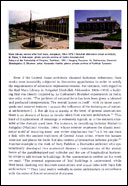Local Modernism and Global Orientalism
Building the “Soviet Orient”, by Boris Chukhovich
In 1926 Moisey Ginzburg wrote a famous article entitled “The National Architecture of the Peoples of the USSR”. This was probably the most programmatic statement ever made by the Constructivists concerning “the East”, The broad generalisations made in the article were based on the architectural environment of the cities of Dagestan and Central Asia, in analysing which Ginzburg came to the conclusion that Soviet architects were here confronted with a “dead East” and a “living East”, As an example of the dead East he gave the medressa of Ulugbek in Samarkand, about which he remarked:
The mosque of Ulug-bek [sic] is the culmination of the once mighty, but now absolutely dead, historical period in Uzbekistan, a gravestone for the now finished period of national development of the Muslims, a period of autocratic oriental tyrants and the apogee of Islamism, which enslaved the living active force of working Muslims; these are forms which are capable of reflecting only the atavistic national idea of the East.
As a counterweight to this there exists “the typical residential district of the oriental kishlak, aul, or city – the starting point for the development of a new national culture of the East.” It is easy to note that Ginzburg’s statements here are based on the most common clichés, clichés that have been unmasked by Edward Said and are evidence, on the one hand, of Ginzburg’s evident incompetence regarding Central Asian architecture, and, on the other, of his confidence in his right to dissect the body of culture into “dead” and “living” – into that which is to be destroyed or preserved in a museum and that which may be retained and used.
Two years later, Ginzburg was commissioned to design the Government House in Alma-Ata. The design has a free and asymmetrical layout of the kind that is characteristic of Constructivism – with an internal courtyard and a number of blocks standing on pilotis that allow free passage through to the other side, in complete accordance with the five principles formulated by Le Corbusier. However, the need for this concept to be discursively fitted to the local context made it necessary for Ginzburg to abstract himself from the original source (Le Corbusier) and reorient himself on local traditions. “In front of the main entrance into the Government House itself,” writes Ginzburg, “on the north side is an open space with columns under the congress hall - a kind of terrace, which has great functional importance given the climatic and living conditions of our East.” Many years later, Selim Magomedov accepted this derivation unquestioningly. He wrote: “Ginzburg took account of the local natural and climatic conditions and living traditions. The blocks of which the House of Government is composed are arranged in such a way as to form a green courtyard in the centre, and in the vestibule in front of the meeting room and among the vegetation on the flat roof there are the open reservoirs (hauzes) that are traditional for Central Asia.”

